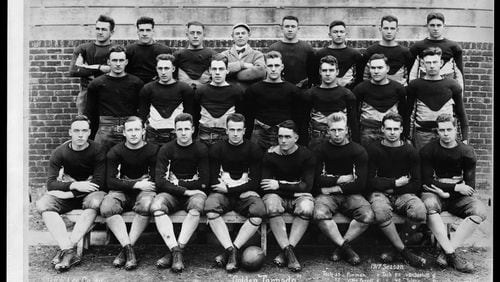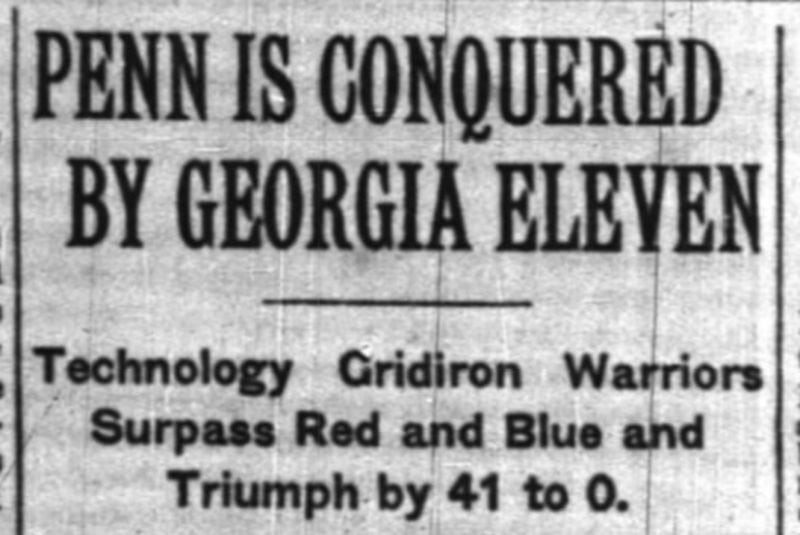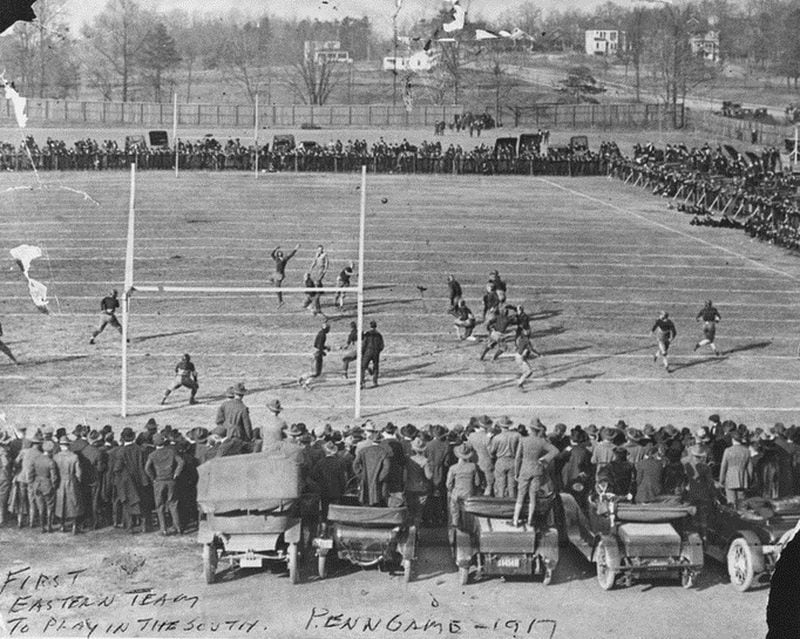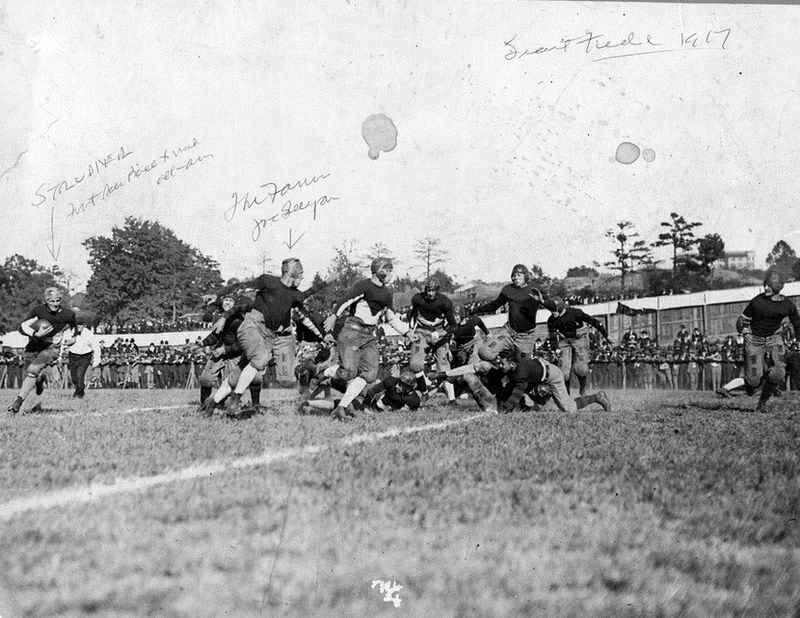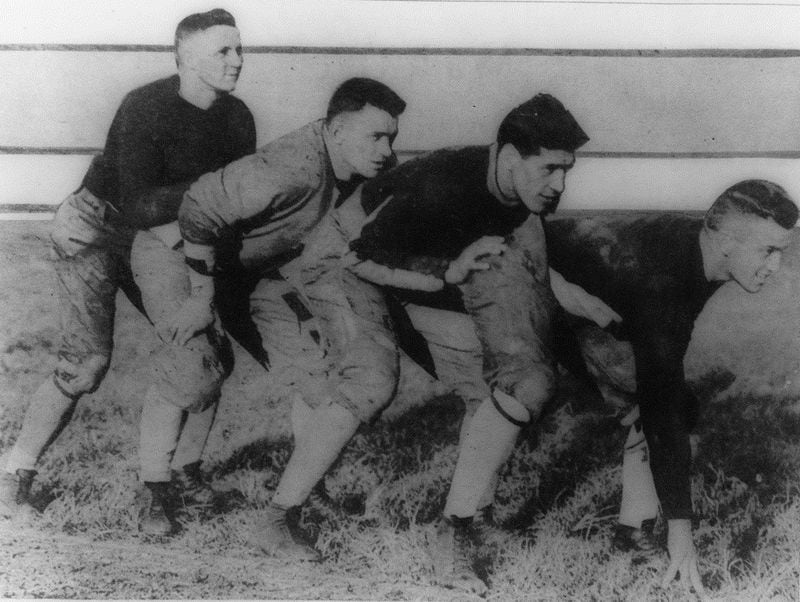This may sound familiar – Georgia Tech scrambling to add a game because of a cancellation. The Yellow Jackets coach trading verbal jabs with a coach from Pennsylvania. An offense not feeling a great compulsion to put the ball in the air.
They’ve been part of the story of the 2017 Jackets, who are 3-1 and going into their open date. Remarkably, they were elements of the Jackets’ season 100 years ago. No matter how this season turns out, though, there is at least one way that it won’t be able to live up to the achievements of its predecessor from 1917 – those Jackets lifted football in the South to a height it had never reached.
In an era that in some ways would be unrecognizable to modern players, coaches and fans but in others would be quite familiar, coach John Heisman’s 1917 Jackets – also known as the Golden Tornado – became the first team outside the East to be widely recognized as a national champion. With a roster largely made up of in-state players, Tech earned the approval of the game’s most influential opinion makers and gave credence to the quality of football away from its base in the Northeast.
The estimation of Walter Camp, a player, coach and writer recognized as the father of American football, said it all in his official guide published for the following season.
“No team of past years has ever made such a general public impression upon the country as that of Georgia Tech, coached by J.W. Heisman, last season,” Camp wrote.
The season’s seminal matchup was played 100 years ago Friday on Grant Field, a 41-0 blowout of powerhouse Penn.
In October 1917, the U.S. was six months into its participation in World War I. Yale, Harvard, Princeton and, locally, Georgia and North Carolina, were among teams to cancel their seasons or play informally as part of the war effort, committing to austerity and/or officer training. Now in his 14th season at Tech and riding a 19-game unbeaten streak, Heisman chose otherwise, seeing football as a vehicle to prepare young men for military service.
A number of players from Tech’s 1916 team, which famously destroyed Cumberland 222-0, had enlisted or had been drafted. The great war was inescapable. On the morning of Oct. 6, Atlantans picking up a copy of the Atlanta Constitution would have found 13 of the 16 headlined stories on the front page relating to the war.
But Tech-Penn had the attention of sports fans, particularly in the South. An Associated Press story advancing the game that called it “one of the most important intersectional games ever played in the South” was on the front of sports pages across the region. The game clearly meant a lot to Heisman, a Penn alumnus.
To fit in the Quakers, who had availability after their game with Army was canceled, Heisman arranged a doubleheader for Tech on Sept. 29, playing (and demolishing) Furman and Wake Forest in the same afternoon. That presumably was not an option that Tech athletic director Todd Stansbury considered as he tried to schedule a 12th game for the Jackets after the game against Central Florida was canceled because of Hurricane Irma.
A visit from Penn, which had six national titles to its credit, was a big deal. The Quakers shared the game’s top billing with the likes of Harvard, Princeton and Yale. The farthest south that they had ever deigned to travel was Virginia.
The game was played before a crowd estimated as large as 25,000, packing the Grant Field concrete stands that remain underneath the west stands of Bobby Dodd Stadium. It was called the largest crowd ever for a game in the South.
The game did not match the buildup. Star halfback Everett Strupper, who was injured in a car accident that morning, scored on a 70-yard touchdown run in the game’s first few minutes, and the rout was on.
Heisman pulled a game-plan misdirection on Penn, switching from his famed “jump shift” – in which linemen stood off the line of scrimmage with the backs behind them, and then just before the snap shifted into a single-wing formation, either left or right. Tech played a more conventional style against Penn, which evidently threw off the Quakers.
The ground game, with halfback Joe Guyon, quarterback Albert Hill and Strupper, hammered Penn so relentlessly “that it was not necessary to call upon the forward pass reservoir for gains,” the Atlanta Constitution’s Hal Reynolds wrote. The New York Sun observed that “Strupper, Guyon and Hill smashed through the Pennsylvania line at will.” The performance no doubt would have pleased the man who inherited Heisman’s office nine decades later, Paul Johnson.
The import of the result was clear. The Philadelphia Inquirer’s headline on the game the next day read, “Penn’s invasion of Southern gridiron results in rout.”
From the Constitution’s game story: “The Tech win marked the first one that a strictly southern team has ever been able to put over on a member of the Big Four – Yale, Harvard, Princeton and Pennsylvania. … The Tech victory should further emphasize the fact that southern elevens have made wonderful strides in the great college sport and should receive the credit that is their due.”
Tech went on to finish the season 9-0, outscoring the opposition 491-17. The Jackets’ supremacy was confirmed for many when Pittsburgh, which would finish 10-0, barely beat the same Penn team 14-6.
The deduction that Tech was better Pitt would spark a back and forth in the newspapers between Penn coach Bob Folwell and Heisman. Because Penn (which finished 9-2) had begun practice less than two weeks before the Tech game, Folwell later said that his team was green, poorly conditioned and could have been beaten by a high-school team. Heisman responded by saying that the Jackets ran only seven plays, using three of them just once each, and stopped trying to score for the last one-third of the game out of respect for his alma mater.
It might strike a familiar tone to Tech fans who relished Johnson’s recent public dismissal of Pitt coach Pat Narduzzi, answering his allegations that the Jackets play “dangerous football” by warning that Tech’s fumbling issues in the 35-17 win over the Panthers would be costly “against a good team.”
Undoubtedly benefiting from the publicity of the win over Penn, Strupper became only the second consensus All-American from the South, while Guyon, Hill and three others were named to All-American teams. And, while the Rose Bowl was in its third year and the AP poll wouldn’t debut for another 19 years, the New York Sun and New York Times were among newspapers to declare Tech their national champions, the first Southern team to earn that distinction. (LSU was retroactively declared a co-national champion of the 1908 season, but the school does not recognize it.)
The Sun’s acclamation: “Never before has the South attained the position in intercollegiate football which it reached during the season just closed. The eleven from the Georgia School of Technology, under the coaching of John W. Heisman, a Pennsylvania alumnus, not only won the championship of Dixie but generally was recognized as the most powerful team in the country.”
Tech’s crushing win over Penn and subsequent championship helped erode the East’s basis for claiming football superiority. Over the next 10 seasons, Michigan, Texas A&M, Notre Dame, California, Illinois, Notre Dame, Alabama and Stanford claimed national championships before Tech won it again in 1928.
Three members of the 1917 team – Strupper, Guyon and Bill Fincher – were inducted into the College Football Hall of Fame along with Heisman. Guyon connects 1917 to modern-day college athletics more directly than you might think. A Native American who played with the great Jim Thorpe at Carlisle, Guyon transferred to Tech after Heisman gave his brother an assistant coaching job. (Guyon has a less slippery link to the 2017 Tech team. He and defensive tackle Desmond Branch might be the only two players in team history from New Mexico.)
These Jackets have largely been lost to history, but they rate among the better and more significant teams in the game’s history.
On the 100th anniversary of the win over Penn, Grant Field likely will be quiet. The Jackets are off this weekend, resting for their Oct. 14 matchup at Miami. The outcome likely won’t carry the same weight as did the one a century ago, but it nevertheless have significant bearing on the trajectory of Tech’s season.
Were he available for counsel, coach Heisman might recommend running the ball.
